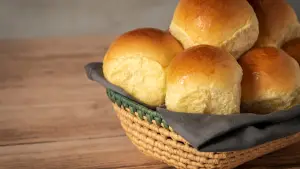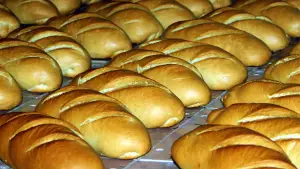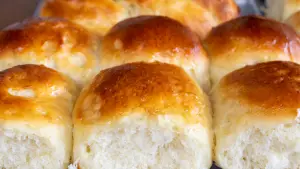Cafeteria rolls, those soft, pillowy bites of goodness, have a special place in our culinary world. These unassuming rolls are more than just bread; they represent comfort, simplicity, and a touch of nostalgia. In this article, we’ll delve into the delightful realm of cafeteria rolls, uncovering their rich history, varied types, and the joy they bring to countless meals.
Historical Background
To truly appreciate cafeteria rolls, it’s essential to understand their origins and the journey that has led them to our cafeteria trays and dining tables today. These rolls have a fascinating historical background, deeply intertwined with the evolution of bread and its cultural significance.
Cafeteria rolls can trace their roots back to ancient civilizations, where bread was a staple food. Bread has been a part of human diets for millennia, dating as far back as the Neolithic era. Early civilizations, such as the Egyptians, Greeks, and Romans, were known for their bread-making skills, and the concept of small, round bread rolls likely emerged during these times.
During the Middle Ages, bread was a central element of European diets, and various types of bread rolls started to appear. These rolls were often made with simple ingredients like flour, water, yeast, and salt. They were baked to perfection in communal ovens and served in taverns and inns.
The concept of cafeteria-style dining, where individuals could select their dishes from a variety of options, gained popularity in the United States during the late 19th century. Cafeterias provided a practical and efficient way to serve large groups of people. It was in these cafeterias that rolls became a beloved accompaniment to hearty meals.
As the cafeteria dining concept evolved, so did the rolls. The soft, fluffy cafeteria rolls we know today are the result of decades of refinement and a commitment to providing comfort food that appeals to all generations.
In the next sections, we’ll explore the different types of cafeteria rolls, their ingredients, and the role they play in our modern culinary landscape. So, join us on this journey through the world of cafeteria rolls, where simplicity meets satisfaction in every bite.
Types and Varieties
Now that we’ve explored the history of cafeteria rolls, let’s dive into the delightful world of their various types and popular varieties. Cafeteria rolls come in a wide array of shapes, sizes, and flavors, catering to diverse palates and preferences.
Types of Cafeteria Rolls
Cafeteria rolls, though seemingly simple, encompass a variety of styles and textures that can elevate any meal. Here, we’ll discuss some of the most common types you’re likely to encounter:
- Dinner Rolls: These are the classic, round, and soft rolls that have been a staple in cafeterias for generations. They are perfect for mopping up gravies and sauces, making them a beloved choice.
- Kaiser Rolls: With their distinctive star-shaped tops and slightly crusty exterior, Kaiser rolls add a touch of sophistication to cafeteria dining. They are often used for sandwiches and burgers.
- Slider Rolls: Smaller in size, slider rolls are ideal for creating mini sandwiches or burgers. They are soft, yielding, and perfect for snacking.
- Whole Wheat Rolls: For those looking for a healthier option, whole wheat rolls are a popular choice. They offer a nutty, wholesome flavor and are rich in dietary fiber.
- Sweet Rolls: Cafeteria-goers with a sweet tooth often enjoy sweet rolls. These may be flavored with ingredients like cinnamon, raisins, or even chocolate chips, adding a sweet twist to your meal.
Popular Varieties
Cafeteria rolls have evolved to cater to a range of tastes, and their popularity has led to the creation of numerous tempting varieties. Here are some of the favorites:
- Garlic Rolls: Infused with aromatic garlic butter, these rolls are a savory delight. They pair exceptionally well with Italian dishes and pasta.
- Cheese Rolls: Cheese lovers rejoice! Cheese rolls are adorned with gooey, melted cheese, offering a delightful blend of textures and flavors.
- Honey Wheat Rolls: These rolls feature the natural sweetness of honey and the nuttiness of whole wheat flour. They are a perfect complement to hearty soups and stews.
- Jalapeño Rolls: For those who crave a bit of heat, jalapeño rolls provide a spicy kick that elevates any sandwich or burger.
- Multigrain Rolls: Packed with a medley of grains and seeds, multigrain rolls are a nutritious choice that adds depth to your meal.
These are just a few examples of the diverse cafeteria roll offerings available today. Cafeteria rolls, in all their forms, play a crucial role in making cafeteria dining a satisfying and enjoyable experience. In the next section, we’ll explore the key ingredients that contribute to the delectable nature of these rolls and provide insight into how they are prepared.
-
- Explore the nuances between fudgy and cakey brownies, perfect for deciding which type to use in your Brownie Bottom Cheesecake.
- Fudgy vs. Cakey Brownies
Ingredients and Preparation
To fully appreciate the delectable world of cafeteria rolls, it’s essential to understand the key ingredients that go into making these pillowy delights. In this section, we’ll explore the main components that create the magic of cafeteria rolls and provide a step-by-step guide on how to prepare them from scratch.
Key Ingredients
- Flour: The foundation of any good roll, flour provides structure and texture. All-purpose flour is commonly used, but variations like bread flour or whole wheat flour can be incorporated for unique flavors and textures.
- Yeast: Yeast is the microorganism responsible for the leavening action in rolls. It consumes sugars and produces carbon dioxide gas, creating the characteristic rise and airy texture. Active dry yeast or instant yeast are typical choices.
- Water: Water is the medium in which yeast activates and helps to hydrate the flour. The temperature of the water is crucial, as it affects yeast activity.
- Sugar: Sugar adds sweetness and serves as a food source for yeast. It also aids in browning during baking. Common types include granulated sugar, honey, or molasses.
- Salt: Salt enhances the flavor of the rolls and helps regulate yeast activity. It also strengthens the dough’s structure.
- Fat: Fat, often in the form of butter, shortening, or oil, adds richness, tenderness, and flavor to the rolls. It contributes to their soft and moist texture.
- Eggs: Eggs can be included for richness and a tender crumb. They also add a golden hue to the rolls.
- Milk: Milk adds moisture, tenderness, and flavor. It can be used in place of water to create a richer dough.
Step-by-Step Preparation
Now, let’s embark on the journey of making cafeteria rolls from scratch. Follow these steps for soft and fluffy rolls:
Cafeteria Rolls Recipe
- Author: Amelia
Ingredients
- 4 cups all-purpose flour
- 1 packet (2 1/4 tsp) active dry yeast
- 1 cup warm water (about 110°F or 43°C)
- 1/4 cup granulated sugar
- 1/4 cup unsalted butter, melted
- 1 tsp. salt
Instructions
- Activate the yeast: In a bowl, combine warm water and sugar. Sprinkle the yeast over the mixture and let it sit for about 5–10 minutes until foamy.
- Mix Dry Ingredients: In a large mixing bowl, combine the flour and salt.
- Combine Wet and Dry: Pour the yeast mixture and melted butter into the dry ingredients. Stir until a dough forms.
- Knead the Dough: Turn the dough out onto a floured surface and knead for about 5-7 minutes until it’s smooth and elastic.
- First Rise: Place the dough in a greased bowl, cover it with a damp cloth, and let it rise in a warm place for 1–1.5 hours until doubled in size.
- Shape the Rolls: Punch down the dough, divide it into portions, and shape them into rolls. Place them on a baking sheet.
- Second Rise: Cover the rolls with a damp cloth and let them rise again for 30-45 minutes.
- Bake: Preheat the oven to 375°F (190°C). Bake the rolls for 15-20 minutes or until they’re golden brown.
- Enjoy: Allow the rolls to cool slightly before serving. Enjoy your homemade cafeteria rolls!
-
- Learn how to make no-bake chocolate coconut balls, a simple yet delightful treat that complements any dessert table.
- Chocolate Coconut Balls
Serving and Pairing
Cafeteria rolls are a versatile delight; we can enjoy them in various ways, and they pair beautifully with a range of dishes and beverages. Here are some suggestions to enhance your cafeteria roll experience:
Serving Suggestions
- Classic Bread Basket: Place cafeteria rolls in a charming bread basket lined with a clean cloth napkin. This classic presentation is perfect for family dinners or formal gatherings.
- Flavored Butter: Elevate your rolls by serving them with a selection of flavored butters. Choices like garlic herb, honey butter, or sun-dried tomato butter can add an extra layer of taste.
- Slider Bar: Mini cafeteria rolls are ideal for creating a slider bar. Offer an array of fillings, like grilled chicken, pulled pork, and various condiments, so guests can build their sliders.
- Soup Dippers: Pair cafeteria rolls with a comforting bowl of soup. Their soft texture makes them excellent for dunking into tomato soup, clam chowder, or a hearty stew.
- Sandwich Rolls: Split cafeteria rolls in half and fill them with your favorite sandwich ingredients. They make delicious sandwiches for picnics or quick lunches.
Pairing with Dishes
- Roast Meats: Serve cafeteria rolls alongside roast meats like turkey, chicken, or beef. They’re perfect for making mini sandwiches with leftover roast.
- Salads: Pair cafeteria rolls with fresh salads. The combination of a crisp salad and soft rolls provides a delightful contrast in textures.
- Barbecue: Cafeteria rolls are a barbecue’s best friend. Use them to make pulled pork or brisket sandwiches, or simply serve them as a side to soak up barbecue sauce.
- Cheese and charcuterie: Include cafeteria rolls on your cheese and charcuterie board. They offer a neutral base to showcase the flavors of various cheeses and cured meats.
- Hot Soups: Enjoy rolls with hot soups, especially during the colder months. Their warmth and softness complement the comforting nature of soups.
- Morning Breakfast: Toasted cafeteria rolls make a wonderful breakfast treat. Spread them with jam, peanut butter, or cream cheese for a satisfying start to the day.
As you can see, cafeteria rolls are incredibly versatile and can enhance the enjoyment of many dishes. Whether you’re serving them at a formal dinner, a casual barbecue, or enjoying them as a comforting snack, these rolls have a place in every meal. In the following section, we’ll explore storage tips to keep your cafeteria rolls fresh for longer periods of time.
Nutritional Value
Cafeteria rolls are undeniably delicious, but it’s essential to consider their nutritional value and explore options for healthier alternatives.
Nutritional Information
Cafeteria rolls, like many bread products, provide a source of carbohydrates, essential for energy. Here’s a brief overview of their nutritional content per serving (one roll, approximately 50 grams):
- Calories: On average, one cafeteria roll contains around 150 calories.
- Carbohydrates: The primary macronutrient in rolls is carbohydrates, providing about 30 grams per serving.
- Protein: You can expect around 4-5 grams of protein in a single roll.
- Fat: Most cafeteria rolls are relatively low in fat, with less than 2 grams per serving.
- Fiber: While not exceptionally high in fiber, rolls offer some dietary fiber, usually around 1-2 grams.
- Vitamins and Minerals: They provide essential nutrients like B vitamins and minerals such as iron, magnesium, and zinc in small amounts.
Healthy Alternatives
If you’re looking for ways to make cafeteria rolls healthier, here are some tips:
- Whole Wheat: Opt for whole wheat cafeteria rolls. They contain more fiber and nutrients compared to rolls made with refined flour.
- Reduced Sodium: Consider reducing the salt content in your rolls, or use alternatives like herbs and spices for flavor.
- Substitute Fats: Swap out some of the fats (like butter) with healthier options like olive oil or Greek yogurt for added moisture and nutrition.
- Add Seeds: Incorporate flaxseeds, chia seeds, or sunflower seeds into the dough for an extra nutritional boost.
- Portion Control: Enjoy cafeteria rolls in moderation as part of a balanced diet. Smaller portions can help control calorie intake.
- Dip Smartly: Instead of high-calorie dips or spreads, pair rolls with hummus, Greek yogurt, or homemade salsa for healthier options.
By making these adjustments, you can enjoy the delightful taste of cafeteria rolls while making them a more nutritious choice.
In the next section, we’ll delve into the cultural significance of cafeteria rolls and their presence in various culinary traditions.
-
- This is a great read for those looking for a healthy and convenient breakfast recipe that offers the comforting flavors of apple pie.
- Apple Pie Overnight Oats
Culture
Cafeteria rolls aren’t just a delightful food item; they often play a significant role in various cultural traditions and find their place in diverse culinary landscapes worldwide.
Traditions
- Thanksgiving Dinner: In the United States, fluffy cafeteria rolls are a staple at Thanksgiving dinners. They serve as perfect vessels for sopping up gravy and complementing the roasted turkey.
- Religious Celebrations: In many cultures, cafeteria rolls are an essential part of religious celebrations, such as communion in Christian traditions. They symbolize sustenance and spiritual nourishment.
- Family Gatherings: Cafeteria rolls are a common sight at family gatherings, potlucks, and picnics, where they often accompany dishes like fried chicken, barbecue, or chili.
- School Lunches: As the name suggests, they have a long history of being served in school cafeterias across the United States. They are often used to make sandwiches or served as a side.
- Dinner Rolls: In more formal settings, such as weddings and banquets, it takes on the role of dinner rolls, gracing dining tables in bread baskets.
Around the World
While cafeteria rolls are synonymous with American culture, variations of soft, yeasted bread we are enjoying worldwide:
- Baozi (China): These steamed buns are filled with various savory or sweet fillings, making them a popular street food.
- Kaiser Rolls (Germany): Known for their distinct round shape and scored tops, Kaiser rolls are a classic accompaniment to sausages and cold cuts.
- Brioche (France): While not a cafeteria roll in the traditional sense, brioche is a buttery, enriched bread that graces French breakfast tables.
- Roti (India): Roti is a simple, unleavened flatbread enjoyed with a variety of curries and dishes across the Indian subcontinent.
- Pandesal (Philippines): These slightly sweet, soft rolls are a breakfast staple in the Philippines, often paired with coffee or hot chocolate.
Cafeteria rolls, in their various forms, have found their way into the hearts and tables of people from different walks of life and regions, serving as a testament to the universal appeal of this humble bread.
In the final section, we’ll address common questions and curiosities about it, shedding light on some frequently asked queries.
FAQs
Let’s dive into some frequently asked questions about it to satisfy your curiosity:
Q1: Are cafeteria rolls and dinner rolls the same?
Cafeteria rolls and dinner rolls share similarities in that they are both soft, yeasted bread rolls. However, the term “cafeteria rolls” is often used to refer to the rolls commonly found in school cafeterias, while “dinner rolls” can encompass a broader range of soft rolls that we served with dinner.
Q2: What’s the secret to making fluffy cafeteria rolls?
A: The key to achieving fluffy cafeteria rolls lies in the dough. Ensure the dough rises adequately, and don’t skimp on kneading. Using warm water, the right amount of yeast, and allowing ample rising time will result in light and fluffy rolls.
Q3: Can cafeteria rolls be frozen?
Yes, it can be frozen to extend its shelf life. Place them in an airtight container or freezer bag, and they should stay fresh for several months. To enjoy, simply thaw and reheat as needed.
Q4: Are cafeteria rolls a healthy choice?
A: Like many bread products, they provide carbohydrates and some nutrients. They can be part of a balanced diet. To make them healthier, consider whole-wheat options and watch portion sizes.
Conclusion
In conclusion, cafeteria rolls hold a special place in the world of bread, known for their softness, versatility, and cultural significance. From school cafeterias to family gatherings and festive tables, these rolls have been a beloved addition to countless meals.




